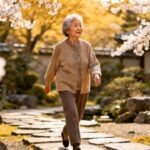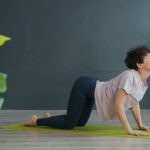Did you know Japan has over 90,000 people living past 100? That’s more centenarians per capita than any other country on Earth. While Americans spend billions on gym memberships and supplements, chronic disease, joint pain, and cognitive decline still hit hard after 50.
So what’s the Japanese secret? It’s not just diet or genetics—it’s six simple daily movements that Western doctors once dismissed as too basic to matter.
The 6 Japanese Daily Movements for Longevity
1. Sampo: The Art of Slow Walking
Forget everything you know about power walking. Sampo is a quiet, mindful form of movement practiced by Japanese elders every morning. You walk at half your normal pace with a specific breathing pattern: inhale for two steps, hold for two steps, exhale for four steps.
This walking-breathing combo syncs your cardiovascular and nervous systems, improves brain clarity, lowers blood pressure, and enhances balance by reactivating deep stabilizing muscles.
A 10-year study from Kyoto University found that seniors who practice sampo daily had 62% less arterial stiffness and walked with the grace of people 20 years younger.
How to start: Begin with 10 minutes on natural terrain like grass or dirt. Focus on rolling each step from heel to arch to toe to activate all 33 joints in each foot.
2. Radio Taiso: The 3-Minute Morning Ritual
Every morning at 6:30 a.m., millions of Japanese perform Radio Taiso—a flowing three-minute routine of 13 gentle stretches designed in 1928. This isn’t a workout—it’s rhythmic continuous movement like arm circles, bends, side stretches, and knee lifts done gracefully.
Studies show that seniors who practice Radio Taiso daily had 40% fewer falls, 55% less chronic back pain, and maintained full range of motion in hips and shoulders into their 80s. The ritual lubricates joints by stimulating synovial fluid, your body’s natural joint oil.
How to start: Do it right after waking up when your body’s growth hormones peak and muscles are most responsive. No equipment needed—just 3 minutes and 15 seconds of gentle movement.
3. Deep Squat Rest: The Lost Human Posture
In Japan, you’ll see elderly people in their 70s and 80s resting comfortably in deep squats—heels flat, back straight, chatting or reading. This isn’t exercise—it’s daily life. And it’s a posture most Westerners have lost due to chairs.
A 12-year study of over 5,000 seniors found that those who could hold a deep squat for at least 2 minutes had a 70% lower chance of needing assisted living. Deep squatting opens hips through their full range, strengthens the pelvic floor, decompresses the spine, and keeps ankles mobile.
How to start: Squat near a wall or sturdy chair. If your heels won’t stay down, place a small rolled towel under them. Hold for 20-30 seconds a few times daily and build up slowly.
4. Single Leg Standing: Balance That Builds the Brain
In Japan, doctors prescribe standing on one leg for 1 minute twice daily. Research shows that seniors who practice this daily had 68% fewer hip fractures, 75% fewer fall-related hospitalizations, and higher gray matter volume in brain areas responsible for balance.
When you stand on one leg, your body makes hundreds of micro-adjustments every minute, activating your core, ankles, hips, and inner ear balance system. Mayo Clinic researchers now say your ability to balance on one leg is a stronger predictor of longevity than cholesterol or blood pressure.
How to start: Stand near a wall or countertop. Lift one foot just 1-2 inches off the ground. Focus on a fixed point ahead. Start with 20-30 seconds each leg. Japanese seniors often do this while brushing their teeth.
5. Floor Sitting Transitions: Your Daily Longevity Test
In Japan, sitting on the floor is daily life—they eat, drink tea, and watch TV on the floor, meaning they get up and down dozens of times daily. This humble movement might be the single best test of how well you’re aging.
A massive study found that seniors who could sit down on the floor and rise back up without using their hands had dramatically better lower body strength, joint flexibility, cognitive scores, and lower mortality rates over 6 years. This transition demands coordination, core stability, spatial awareness, and motor planning.
How to start: Lower yourself into a kneeling position using a chair or low stool. Practice rising back up using support as needed. Even 2-3 transitions daily builds noticeable strength over time.
6. Towel Twist: The 2-Minute Movement That Rewires Your Body
This simple movement—holding a towel at shoulder height, pulling outward gently, and slowly twisting your torso—is credited by many Japanese centenarians as their number one secret to staying strong and mobile into their 90s.
Brain scans show this movement activates both hemispheres simultaneously, enhancing coordination, memory, and reaction time.
A 20-year study found that seniors who practice towel twist daily for just two minutes lived seven years longer on average, maintained grip strength into their 90s, and had bone density 20 years younger than their peers.
How to start: Do it first thing in the morning and again before bed. Hold the tension for 3 seconds on each side while maintaining gentle outward pull on the towel.
Getting Started Safely
If you’re dealing with joint pain, poor balance, or haven’t moved much in years, start where you are. These movements aren’t about perfection—they’re about consistency and intention.
Safety tips:
- Always practice near a wall, countertop, or sturdy chair for support
- Start with standing movements first like sampo or towel twist
- For deep squats or floor transitions, use cushions or supports
- Listen to your body—pain is not progress
- Consult your doctor or physical therapist for specific concerns
The Mindset Shift for Longevity
These six movements take less than 15 minutes daily and require no sweat, willpower, or expensive equipment. What they do require is a mindset shift—from trying to fight age to flowing with it intelligently.
Japanese elders don’t do these movements because they want to live forever. They do them because they want to live well—clear-headed, strong, and independent for as long as life allows.
You can start with just one movement, one minute, one choice, and that single decision could ripple into years of better balance, brain health, and vitality.
The choice to age differently starts today. You don’t need to move to Japan to age like the Japanese—you just need to move with purpose.








